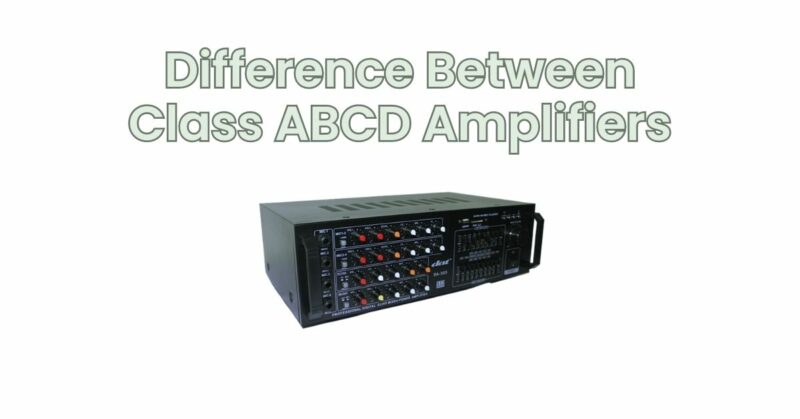Amplifiers play a crucial role in audio systems, providing power and amplification to drive speakers. When exploring amplifier options, you may come across different amplifier classes, such as Class AB, Class B, Class C, and Class D. Each class represents a distinct amplifier design and operation, with unique characteristics and performance attributes. In this article, we will delve into the differences between these amplifier classes, helping you understand their strengths, weaknesses, and applications.
- Class AB Amplifiers: Class AB amplifiers are a popular choice in many audio systems. They combine elements of both Class A and Class B designs to achieve a balance between audio fidelity and efficiency. Here are key features of Class AB amplifiers:
- Cross-Over Distortion Reduction: Class AB amplifiers minimize the cross-over distortion present in pure Class B amplifiers by using a biasing arrangement. This biasing keeps a small amount of current flowing through the output transistors, even when there is no input signal, reducing distortion during signal transitions.
- Improved Efficiency: Compared to Class A amplifiers, Class AB amplifiers offer improved efficiency. However, they are not as efficient as Class D amplifiers. Class AB amplifiers are suitable for applications where moderate power output and audio fidelity are important, such as home audio systems, studio monitors, and live sound reinforcement.
- Class B Amplifiers: Class B amplifiers are known for their efficiency but can introduce distortion due to their crossover behavior. Here are key features of Class B amplifiers:
- Push-Pull Configuration: Class B amplifiers utilize a push-pull configuration with two output transistors, each handling one half of the audio waveform. One transistor amplifies the positive half of the signal, while the other amplifies the negative half.
- Efficiency: Class B amplifiers are more efficient than Class A amplifiers since power is only consumed when there is an input signal. However, they can suffer from crossover distortion, which is the result of a small gap in amplification between the positive and negative half-cycles of the waveform.
- Applications: Class B amplifiers find applications in battery-powered devices, such as portable audio players, due to their efficiency and ability to conserve power.
- Class C Amplifiers: Class C amplifiers are primarily used in applications where high efficiency is the priority, such as RF (Radio Frequency) amplification. Key features of Class C amplifiers include:
- High Efficiency: Class C amplifiers are highly efficient but are not suitable for accurate audio reproduction due to their high distortion. They are commonly employed in applications where fidelity is not critical, such as RF signal amplification for radio transmitters and wireless communication systems.
- Narrow Amplification: Class C amplifiers are biased to conduct current for less than half of the input cycle, resulting in an output waveform that is heavily distorted and contains a high level of harmonic content. They are typically used in circuits that require amplification of specific frequency ranges.
- Class D Amplifiers: Class D amplifiers, also known as switching amplifiers, are renowned for their high efficiency and compact size. Key features of Class D amplifiers include:
- Pulse-Width Modulation (PWM): Class D amplifiers use PWM techniques to convert the input audio signal into a series of high-frequency digital pulses. These pulses are then amplified by switching the output transistors on and off rapidly.
- High Efficiency: Class D amplifiers are exceptionally efficient, with efficiency ratings often exceeding 90%. This efficiency is achieved by minimizing power dissipation in the output transistors, resulting in less heat generation.
- Compact Size: Due to their efficient design, Class D amplifiers can be morecompact and lightweight compared to other amplifier classes. This makes them well-suited for portable audio devices, car audio systems, and other applications where space is limited.
- Audio Fidelity: Class D amplifiers have made significant advancements in recent years, and many modern designs offer excellent audio fidelity. However, some audiophiles may still prefer the warmth and accuracy of Class AB amplifiers for critical listening applications.
Conclusion: Understanding the differences between Class AB, Class B, Class C, and Class D amplifiers is essential for selecting the right amplifier for your audio system. Class AB amplifiers strike a balance between audio fidelity and efficiency, making them suitable for various applications. Class B amplifiers prioritize efficiency but can introduce crossover distortion. Class C amplifiers excel in high efficiency but sacrifice audio fidelity. Class D amplifiers are highly efficient and compact, making them ideal for portable and space-constrained applications, though their audio performance has improved significantly over time.
When choosing an amplifier, consider your specific requirements, such as desired audio fidelity, power output, efficiency, and size constraints. Ultimately, the right amplifier class depends on the application, personal preferences, and the specific demands of your audio system.


